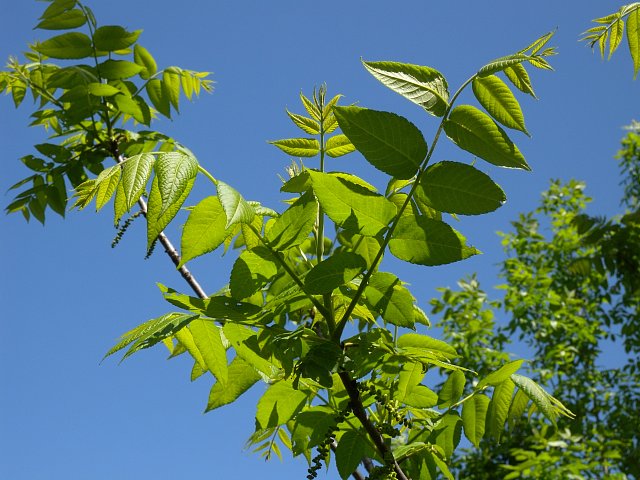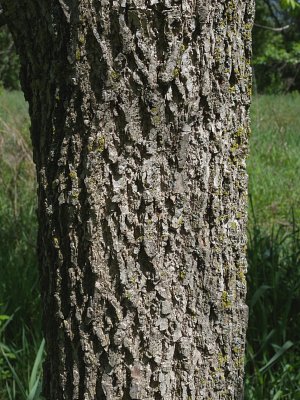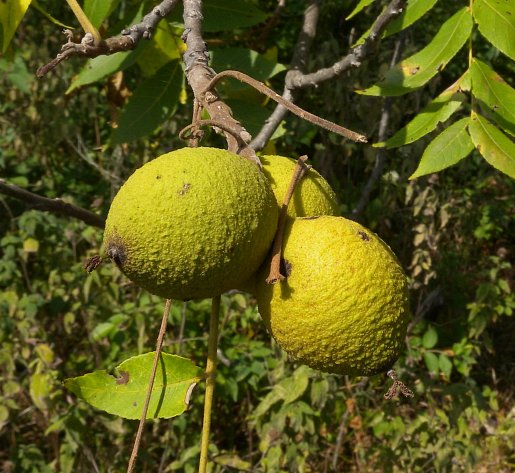Description: This tree is 80-120' tall at maturity, forming an ovoid crown and tall trunk. On mature trees, the trunk is 3-6' across, developing a deeply furrowed bark that is gray to nearly black. The bark of branches is more smooth and gray. Alternate compound leaves are 1-2' long and ½' across; their structure is odd-pinnate, although the terminal leaflet is often deformed or missing. Individual leaflets are about 3" long and 1" across; they are lanceolate or ovate-lanceolate, serrated along their margins, and nearly sessile. The upper leaflet surface is medium green and glabrous, while the lower surface is pale green and short-pubescent along the ribs of the veins. The rachis (central stalk) of each compound leaf is light green to pale brown and short-pubescent. The rather stout petioles of the compound leaves are 3-6" long, light green to greenish brown, and pubescent.

Black Walnut is monoecious with individual trees bearing both male (staminate) and female (pistillate) florets. The male florets occur on dangling cylindrical catkins about 3-6" long. Individual male florets are about 1/8" (3 mm.) across, consisting of a short tubular calyx with 2-6 lobes and 15-40 stamens. The female florets occur on short spikes in groups of 2-5. Individual female florets are about 1/8" (3 mm.) across, consisting of a short tubular calyx with 4 lobes and a pistil with a pair of styles. The calyxes of both male and female florets are short-pubescent. The blooming period occurs during late spring as the leaves begin to develop. The florets are cross-pollinated by the wind, although female florets are often self-fertile should cross-pollination fail to occur. Fertile female florets develop into ovoid-globoid nuts about 2½" long and 2" across that occur either individually or in pairs. These nuts are covered with thick green husks that later become yellowish brown and finally black. The husks are covered with a pimply surface and they are aromatic. When the nuts are harvested before their husks blacken, the shells of the nuts are light brown and wrinkled. Each nut is incompletely 4-celled and contains edible meat that is sweet and slightly bitter. The root system consists of a deep taproot and widely spreading lateral roots. This tree reproduces by reseeding itself. The deciduous leaves turn yellow and fall to the ground rather early during the autumn.
Cultivation: The preference is full or partial sun, moist conditions, and deep soil containing loam, silty loam, or sandy loam. The pH of the soil should be slightly acid to neutral. This tree tolerates spring flooding if it is temporary. Because of the deep taproot, it is difficult to transplant successfully. To germinate the nuts, they must be subjected to cold winter temperatures for 90-120 days. The resulting seedlings may produce nuts as early as 5 years, but significant production of nuts doesn't occur until they become 10-15 years old.

Range & Habitat: In Illinois, the native Black Walnut is a common tree that is probably found in every county of the state (see Distribution Map). Habitats consist of rich mesic woodlands, moist bottomland woodlands in valleys and along rivers, and the bases or lower slopes of bluffs. Black Walnut is found in deciduous woodlands with moisture-loving maple, hickory, oak, and ash trees. Sometimes this tree is planted deliberately because of its edible nuts and valuable wood.
Faunal Associations: Insects that consume the leaves, bore through the wood, suck plant juices, and feed on other parts of Black Walnut include the larvae of wood-boring beetles, leaf beetles, plant bugs, stink bugs, aphids, leafhoppers, treehoppers, armored scales, larvae of moths, and larvae of a butterfly, the Banded Hairstreak (Satyrium calanus falacer). The Insect Table provides a more complete list of these insect feeders. Mammals that feed on nuts of this tree include the Eastern Gray Squirrel, Fox Squirrel, and American Red Squirrel. Several birds also eat the nuts, or pieces of meat from nuts that have already opened (see Bird Table). They include the American Crow, Pileated Woodpecker, Red-bellied Woodpecker, Blue Jay, and Northern Cardinal. Several species of bats use Black Walnut as a roost tree during the daytime. This includes the Eastern Red Bat, Northern Long-eared Bat, and Tricolored Bat. It also serves as a roost tree for the Eastern Screech Owl (Mager & Neslon, 2001; Krynak, 2010; Zimmerman, 2015; Veilleux et al., 2003; Belthoff & Ritchison, 1990).
Photographic Location: Meadowbrook Park in Urbana, Illinois.

Comments: Because of its nuts and high quality wood, Black Walnut is a valuable tree, although a rather messy one. The rotting husks of the nuts can stain side sidewalks and driveways a brown-black color that is difficult to remove. Even immature green husks can stain your fingers yellow when they are handled. The closest relative of Black Walnut in Illinois is the less common Juglans cinerea (Butternut), which has been declining in numbers because of disease. The nut husks of Butternut are more smooth and pubescent than those of Black Walnut, and its nuts are a little smaller in size and more narrowly ovoid in shape. The young branchlets of Butternut are downy, while those of Black Walnut are smooth. In general, both Butternut and Black Walnut differ from the related Carya spp. (Hickories) by their unsegmented nut husks and the chambered (or partitioned) pith of their twigs.